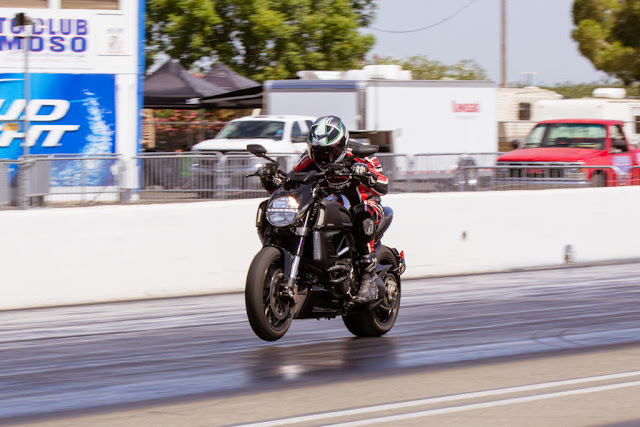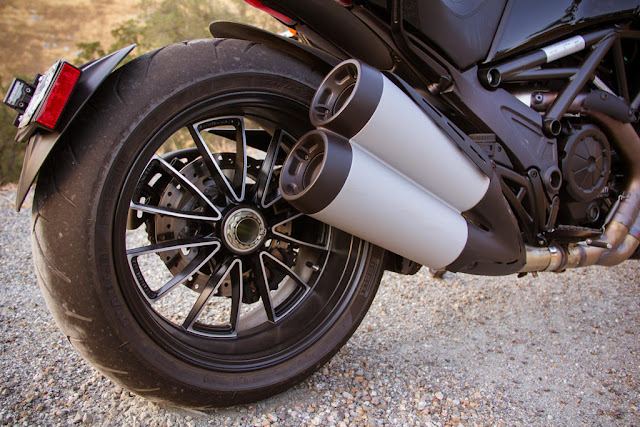DUCATI DIAVEL CROMO VS STAR MAX
The VMAX postures like a dominant silverback gorilla but the Diavel refuses to be intimidated by the size and power of its opponent. In the annals of imaginary dream fights this matchup is akin to a young Mike Tyson in the ring with an equally youthful Muhammad Ali, or a movie where the Terminator is programmed to kill James Bond. While not exactly a David vs Goliath scenario, the Diavel vs VMAX is certainly a bout for the ages between the brute finesse of the Ducati and the cudgeling strength of the YamaStar.
For more than 20 years the V-Max was part of the motorcycling lexicon. Reborn in 2009 with the first full overhaul since its introduction in 1985, the VMAX (note the tweaked nomenclature) boasts a nearly 500cc increase (from 1,197cc to 1,679cc) in engine capacity and a massive bump in power (see dyno chart). A modern cult bike without equal, the VMAX not only owns the power-cruiser class, it’s the bike that created the species.
The arrival of the Diavel last year as a pretender to the VMAX’s crown, signifies a departure from Ducati’s unapologetic lineup of sporting models. The Diavel is not Ducati’s first feet-forward motorcycle, but this modern power-cruiser in no way compares with the damnable Indiana of the mid-’80s. “I'll admit it was weird to place my feet in front of me on a Ducati, that's something I've never done before,” says editor-at-large, Troy Siahaan.
Armed with the latest in electronic technology and motivated by a version of the Testastretta 11° V-Twin first seen in the Multistrada, Ducati certainly didn’t bring a knife to a gunfight. For the motorcycle/firearm aficionado, it’s a matter of preference between the sharp shooting accuracy of a high-powered rifle (Diavel) or the remorseless brutality of a rotary machine gun (VMAX).
Fourteen Hundredths:
A bike has to be straight-line fast to qualify as a power-cruiser, and the only place to prove its merit is at the dragstrip. We knew the results would be close before either bike was launched, but the end result surprised all in attendance.
In the capable hands of MO’s dragstrip specialist, Editor Duke put the Diavel through the lights at Famoso Dragway outside Bakersfield, California, in a very respectable time of 10.30 seconds at 131.3 mph. Corrected for temperature and air pressure, the ET converts to a seriously quick 9.95-second pass.
Switching to the VMAX Duke mustered a 10.16 at 136.1 mph (corrects to 9.81 at 140.9). Yep, 0.14 of a second is all that separated the two at the line, awarding the VMAX bragging rights, but only marginally.
Boasting an engine with two more cylinders, 481 more cubic centimeters, 41.8 more horsepower and 31.2 more foot pounds of torque, how could the VMAX not have obliterated the Duc by a larger margin?
The first problem is a result of the MAX’s choice of final drive. “Using a shaft drive makes the rear suspension rise up under acceleration, limiting the amount of traction-enhancement from a bike’s weight transfer,” Duke comments.
The shaft final drive harbors some responsibility, but the greatest contributing factor is the VMAX’s substantial heft.
At a claimed 683 pounds full of fluids the VMAX outweighs the claimed 527-pound wet weight of the Diavel by a whopping 156 pounds. Calculating the power-to-weight ratio of each bike is revealing, with a closer figure than that of their dragstrip times: 0.258 horsepower per pound for the VMAX vs 0.255 horsepower per pound for the Diavel – basically identical.
For more than 20 years the V-Max was part of the motorcycling lexicon. Reborn in 2009 with the first full overhaul since its introduction in 1985, the VMAX (note the tweaked nomenclature) boasts a nearly 500cc increase (from 1,197cc to 1,679cc) in engine capacity and a massive bump in power (see dyno chart). A modern cult bike without equal, the VMAX not only owns the power-cruiser class, it’s the bike that created the species.
The arrival of the Diavel last year as a pretender to the VMAX’s crown, signifies a departure from Ducati’s unapologetic lineup of sporting models. The Diavel is not Ducati’s first feet-forward motorcycle, but this modern power-cruiser in no way compares with the damnable Indiana of the mid-’80s. “I'll admit it was weird to place my feet in front of me on a Ducati, that's something I've never done before,” says editor-at-large, Troy Siahaan.
Armed with the latest in electronic technology and motivated by a version of the Testastretta 11° V-Twin first seen in the Multistrada, Ducati certainly didn’t bring a knife to a gunfight. For the motorcycle/firearm aficionado, it’s a matter of preference between the sharp shooting accuracy of a high-powered rifle (Diavel) or the remorseless brutality of a rotary machine gun (VMAX).
Fourteen Hundredths:
A bike has to be straight-line fast to qualify as a power-cruiser, and the only place to prove its merit is at the dragstrip. We knew the results would be close before either bike was launched, but the end result surprised all in attendance.
In the capable hands of MO’s dragstrip specialist, Editor Duke put the Diavel through the lights at Famoso Dragway outside Bakersfield, California, in a very respectable time of 10.30 seconds at 131.3 mph. Corrected for temperature and air pressure, the ET converts to a seriously quick 9.95-second pass.
Switching to the VMAX Duke mustered a 10.16 at 136.1 mph (corrects to 9.81 at 140.9). Yep, 0.14 of a second is all that separated the two at the line, awarding the VMAX bragging rights, but only marginally.
Boasting an engine with two more cylinders, 481 more cubic centimeters, 41.8 more horsepower and 31.2 more foot pounds of torque, how could the VMAX not have obliterated the Duc by a larger margin?
The first problem is a result of the MAX’s choice of final drive. “Using a shaft drive makes the rear suspension rise up under acceleration, limiting the amount of traction-enhancement from a bike’s weight transfer,” Duke comments.
The shaft final drive harbors some responsibility, but the greatest contributing factor is the VMAX’s substantial heft.
At a claimed 683 pounds full of fluids the VMAX outweighs the claimed 527-pound wet weight of the Diavel by a whopping 156 pounds. Calculating the power-to-weight ratio of each bike is revealing, with a closer figure than that of their dragstrip times: 0.258 horsepower per pound for the VMAX vs 0.255 horsepower per pound for the Diavel – basically identical.


